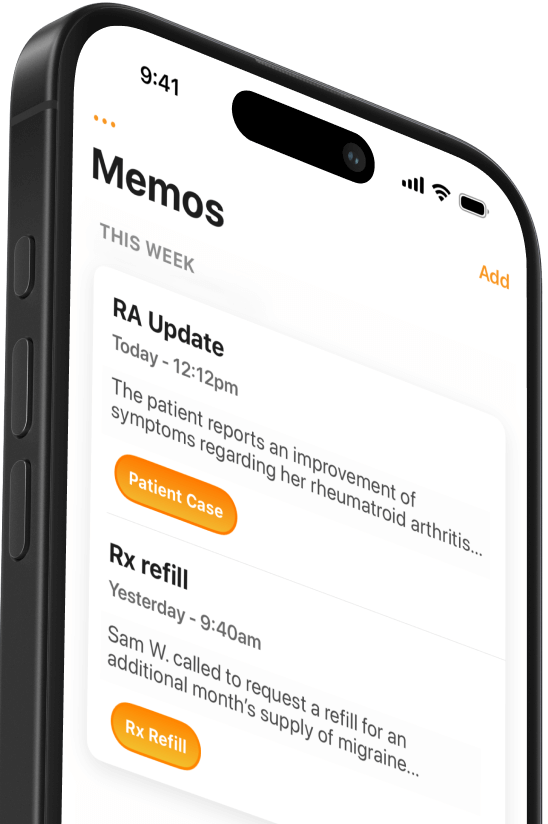Which medical dictation workflow is best for you?
Discover five medical dictation workflows—from basic transcription to AI-powered tools—that could save hours every week.


Popular articles
Medical dictation has changed substantially due to improvements in voice recognition software and generative AI. When many of today's physicians began their careers, dictating clinical notes required a transcriptionist to sit in on every visit. Today, a wide range of medical dictation workflows - enabled by groundbreaking technology advancements - offer greater flexibility and lower costs.
At a time when many providers spend over 15 hours weekly on data entry, efficient medical dictation is one of the best ways to streamline documentation. Put simply, talking is faster than typing. Consider trying one of these approaches if you don’t already dictate clinical notes.
Which medical dictation workflow is best for your practice?
This article discusses five distinct medical dictation workflows to help physicians decide what approach best fits their needs:
- Simple transcription
- Computer-enabled transcription
- Direct EMR speech-to-text
- Mobile dictation
- AI medical scribe
Rather than focus on specific product recommendations, we will outline the various technology-enabled approaches to the medical dictation process. If you’re interested in software advice, read about The Best Free Medical Dictation Apps or consider Mobius MD’s industry-leading dictation solution for iPhone.
Option 1: Simple transcription
This first option is as simple as it gets. As the physician, you dictate directly into a digital voice recorder that saves your dictation as an audio file. You send the file to a medical transcriptionist, who could be part of your staff or off-site. The transcriptionist listens to the dictation and types what they hear into the EMR. After they complete the transcription, you review the note for accuracy.
Recording your dictations in this scenario is equivalent to having a medical scribe in the room who completes notes on your behalf. The only difference is that recording allows the transcriptionist to be off-site or to complete notes asynchronously.
- Benefits: No extra time is required for the physician. There's no need to learn new software or workflows.
- Costs: Simple transcription requires extra staff salary or paying for an off-site transcription service. The final note may not be completed for several hours or even several days, and the physician must return to the note for final review.
- Who it’s good for: Physicians who don’t want to learn a new workflow and have a budget to allocate to transcription services or additional staff.
Option 2: Computer-enabled transcription
Computer-enabled transcription is the workflow modern medical transcription services will use if you send your dictations off-site, but you could also set this up in the office. As the physician, you still dictate into a voice recorder but with attention to the clarity of your speech. Speech-to-text software automatically transcribes your words before a trained assistant corrects errors by listening to the recording.
Because a computer is doing the initial transcription, you need to speak clearly and at a moderate pace with good pronunciation. As with the first option, you will want to check the final transcript for accuracy.
- Benefits: No extra time is required for the physician. There's no need to learn new software.
- Costs: This approach requires new attention to clarity when speaking dictations. The price of transcription services may be lower than Option 1, but in-office workflow also requires purchasing transcription software. The final note may not be completed for several hours or even several days, and the physician must return to the note for a final review.
- Who it’s good for: Physicians who can speak clearly, have no time to review a transcript themselves and have a budget to allocate to transcription services or additional staff.
Option 3: Direct EMR speech-to-text
Direct EMR speech-to-text has become efficient in the past decade because of considerable improvements in voice recognition software.
As with the previous dictation workflow, you speak your note into a microphone with attention to clarity and pace. The difference is that your words appear in real-time in the EMR, so you can proofread the dictation immediately and make any edits before saving.
You can use a workstation dictaphone for this workflow or the built-in mic on your smartphone, laptop, or desktop computer. To dictate directly into the EMR, you’ll need software compatible with your EMR or a dictation solution that allows you to dictate anywhere you can type.
- Benefits: Transcription is instant, and the physician can review and close the chart immediately. Direct EMR speech-to-text is extremely accurate and the lowest cost option because there's no need for additional staff or third-party transcription service.
- Costs: While much faster than typing, this approach still requires review and editing by the physician. You must purchase a subscription to medical speech-to-text software.
- Who it’s good for: Physicians who are cost-efficient and don’t mind learning a new, streamlined workflow. In exchange, you get accurate notes that arrive directly into the EMR with no additional typing.

Option 4: Mobile dictation
Mobile dictation is similar to the previous workflow but with the flexibility of software installed on your smartphone or tablet. As the physician, you use a smartphone app to dictate on a paired computer anywhere you place your cursor. Your words appear as you speak, and you make any edits in real time.
You can easily combine mobile dictation with a desktop speech-to-text workflow. The benefit of mobile is that you aren’t tethered to a particular workstation with the right software installed. For example, apps like Mobius Conveyor use secure dictation memos to record a dictation on your smartphone and send it to the EMR when you’re back at your workstation.
Mobile dictation enables you to dictate clinical notes anywhere, whenever you have a spare minute. Some physicians even dictate their notes on a mobile device during the patient visit. Mobile dictation can turn documentation time into a meaningful patient interaction, ensure accuracy, and save hours weekly.
- Benefits: Transcription is instant, accurate, and affordable. You can dictate your notes from anywhere. This approach allows flexibility and creative solutions for cutting documentation time and improving patient engagement.
- Costs: Mobile speech-to-text requires comfort with mobile device technology like smartphones. You also must purchase mobile-ready medical speech-to-text software.
- Who it’s good for: Physicians who are comfortable using mobile devices, change workstations often, and want to dictate while traveling.
Option 5: AI medical scribe
The rapid emergence of generative AI technologies like ChatGPT has produced a fifth dictation workflow: AI medical scribes. Using “ambient clinical intelligence,” AI scribes replace manual documentation with computer-written notes.
Many AI scribes use smartphone-based software. Using this workflow, the provider introduces the patient to the technology and then tells the AI-enabled software to start “listening.” The software transcribes the patient-provider interaction, extracts relevant information, and produces a structured clinical note in a pre-determined format. The provider checks the note for accuracy before saving it in the EMR.
While companies like Augmedix have made AI medical scribes for several years, 2022 and 2023 saw substantial growth in this area. As of 2024, many products are available, including DAX Copilot, Conveyor AI, and DeepScribe.
- Benefits: No dictation is necessary, freeing providers to focus entirely on the patient. AI medical scribes can reduce documentation time by over 80%.
- Costs: AI medical scribe subscriptions are more expensive than dictation software. Some patients may be uncomfortable with AI scribes, and physicians still need to review for accuracy.
Who it’s good for: Physicians who don’t want to take clinical notes and are interested in cutting-edge medical documentation technology.
Related Articles


We Get Doctors Home on Time.
Contact us
We proudly offer enterprise-ready solutions for large clinical practices and hospitals.
Whether you’re looking for a universal dictation platform or want to improve the documentation efficiency of your workforce, we’re here to help.





